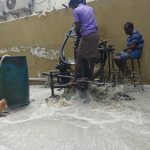From Start to Finish: A Step-by-Step Guide to Drilling a Borewell on Your Property
Introduction
Welcome to this interactive blog on the topic, ‘From Start to Finish: A Step-by-Step Guide to Drilling a Borewell on Your Property’. In this blog, we will be discussing the entire process of drilling a borewell on your property, from start to finish. A borewell is an essential component of many residential and commercial properties, especially in areas where water supply is scarce.With a borewell, you can access groundwater and ensure a constant supply of water for your needs.
Are you looking for reliable borewell drilling services in Chennai? Look no further! We’ve got you covered. Our services include hand borewell drilling services, borewell contractor services,and borewell drilling services in Chennai. Our experienced professionals use the latest drilling rigs and techniques to ensure a seamless and efficient borewell drilling process.
Samy Borewell is a well-known business in Chennai that offers borewell drilling services for your needs.
Step-by-step guide
So, let’s get started with the step-by-step guide. With our step-by-step guide, you can rest assured that your borewell drilling process will be hassle-free and done to perfection. We also offer maintenance and repair services to ensure that your borewell operates effectively for years to come. Contact us today to get started on drilling your borewell!
Step 1: Site Inspection and Selection
The first step in drilling a borewell is to identify the right site. A site inspection helps determine the best location for drilling the borewell. The site should be accessible, preferably close to the area where water is needed, and should have a stable soil structure. If the site is located on a
slope, it is advisable to have the borewell at the bottom of the slope to ensure that water flows towards the borewell.
During the site inspection, it is important to look out for any potential hazards such as overhead power lines or underground cables. You can also take into consideration the distance from the nearest power source or electrical connection, as this will affect the installation of the pump and motor later on.
Step 2: Soil Testing
The next step is to conduct soil testing to determine the soil structure and its water-bearing capacity. This will help determine the depth at which the borewell needs to be drilled. Soil testing can be done using a drilling rig or manual methods. A professional or a geologist can help you conduct soil testing.
The soil test involves taking soil samples at various depths to determine the soil type, texture, and water-bearing capacity. This information helps determine the borewell’s depth, diameter, and screen slot size. The borewell’s depth depends on the soil type and the water table’s location.
Step 3: Borewell Drilling
Once you have identified the site and completed soil testing, you can start drilling the borewell. You will need a borewell drilling rig, which can be rented or hired from a professional drilling company. The drilling rig is used to dig a borehole into the soil to reach the water table.
During the drilling process, it is important to monitor the borewell’s progress regularly. This will help determine the depth at which water is found and the type of soil layers that the borewell passes through. The drilling process can take anywhere from a few hours to a few days, depending on the depth and type of soil.
Step 4: Casing and Screen Installation
When the borewell has been drilled, it is crucial to attach a casing and a screen. The borehole’s casing is lined with a pipe to keep it from collapsing and safeguard the water supply from pollution. The screen serves as a filter to keep debris out of the borewell.
To seal the annular gap between the casing and the borehole, cement grout is poured around the casing pipe before it is lowered into the hole. The screen is then fastened to the casing’s base. The findings of the soil test are used to establish the screen slot size.
Step 5: Development and Testing
The next step is to develop the borewell by flushing it with water to remove any debris and increase its yield. This process is done by circulating water at a high velocity to remove the fine soil particles that entered the borehole during the drilling process.
Once the borewell is developed, testing its water quality and yield is important. This can be done by a professional or a water testing lab. The water yield is determined by measuring the amount of water that the borewell can produce over a certain period.
Step 6: Pump and Motor Installation
After the borewell has been tested and deemed fit for use, the next step is to install a pump and motor to extract water from the borewell. The type of pump and motor to be used will depend on the depth and yield of the borewell. The pump and motor should be installed professionally, and they should be properly sized to match the capacity of the borewell. The pump should be placed at the bottom of the borewell, and the motor should be installed at the top.
Step 7: Electrical Connections
To guarantee that the pump and motor operate effectively after installation, electrical connections must be made. A certified electrician with experience installing submersible pumps should do this. To avoid risks of electrical shock, the electrical connections must be properly grounded.
Step 8: Commissioning and Maintenance
The borewell can be used when it has been set up, tested, and commissioned. However, for the borewell to continue operating effectively, frequent maintenance is necessary. The borewell must be cleaned regularly, and the pump and motor must be examined. The water must also be tested for purity.
The borewell will be examined for leaks or damage to the casing, screen, or pump while undergoing maintenance. Also, the condition of the motor and pump will be examined for damage, and any required maintenance or replacements will be carried out.
To maintain the borewell running well, it is advised to have a regular maintenance programme in place. A specialist can advise on how frequently the borewell has to be repaired based on criteria like consumption, and location, The borewell will be examined for leaks or damage to the casing,
screen, or pump during the maintenance procedure. Also, the motor and pump will be examined for damage and any required repairs or replacements will be done.
To maintain the borewell operating effectively, it is advised to implement a regular maintenance programme. Based on variables including consumption, location, and water quality, a specialist can advise on how frequently the borewell has to be serviced.
conculsion
Borewell drilling is a difficult procedure that needs to be carefully planned and carried out. It’s crucial to follow the instructions given above to guarantee that the borewell is drilled accurately and operates well. To guarantee the borewell is drilled to the proper depth and prevent any mishaps or injuries, remember to work with a competent drilling firm or geologist. You can make sure that you have enough water to meet your demands at all times with the correct preparation and execution.
Wondering about the borewell drilling cost per feet in Chennai? Contact us for a personalized quote based on your requirements. Our team will conduct a site inspection and soil testing to determine the depth and diameter of the borewell, the screen slot size, and the type of pump and motor required for your property.





